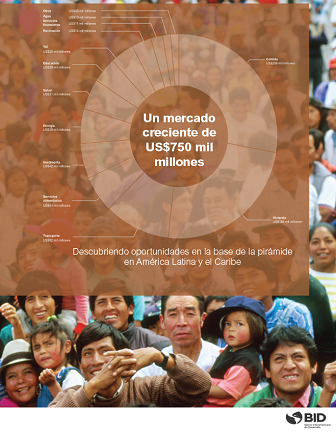Companies that forge a customer relationship with the market sector through loyalty will reap the benefits of its economic progress
CONSUMPTION
7 keys to understanding the base of the pyramid in Latin America and the Caribbean
It is a more urban and connected population, with higher purchasing power and education.

HIGHLIGHTS
The base of the pyramid refers to the group of consumers that currently represent 70% of the population in Latin America and the Caribbean, roughly 405 million people comprising a market of over US$ 750 billion per year. This offers a huge opportunity for companies that are interested in these consumers, visionary investors and entrepreneurs.
“What we call the base of the pyramid is not a static social group. They are citizens characterized by having unsatisfied needs, but also for being a highly dynamic segment of the population with evolving ambitions, preferences and priorities,” affirmed the President of the Inter-American Development Bank (IDB), Luis Alberto Moreno.
Below we provide some keys to understanding the base of the pyramid in our region, according to a report prepared by IDB: “A Rising US$750 Billion Market: Unlocking opportunities at the base of the pyramid in Latin America and the Caribbean.”
- Composition: The base of the pyramid is made up of households whose members earn up to US$ 10 per capita per day and represent around 70% of the region’s population, in other words, 405 million people. Three quarters are in urban areas and have access to basic services including water and electricity.
- Heterogeneity: The base of the pyramid is not a monolithic bloc of millions of people with equal demands and aspirations. Some live on less than US$4 per day, the poor, which do not have the resources or the sufficient capacity to satisfy their current needs. Those living on US$4 to US$10 per day, called the vulnerable, can satisfy some needs and are close to reaching the middle class.
- Discretional spending: The base of the pyramid as we knew it ten years ago has drastically changed. Growth in the region between 2000 and 2013 had a positive impact on the income and welfare of those at the base of the pyramid. Most people in this segment increased their purchasing power, thereby increasing spending on discretionary goods and services by 33% between 2000 and 2010.
- Migration: Between 2000 and 2010 there was a 2% annual increase on income per capita at the base of the pyramid, which is at odds with the total population that remained relatively constant. This trend is expected to continue and more households will graduate into the middle class. It is estimated that by the year 2020 the population at the base of the pyramid will have diminished by 6% due to this migration. However, the market will continue to grow in net terms since an increase of at least 10% in the average income is expected.
- Market: This is doubly attractive since while the size and purchasing power of the population increases, part of the population that was at the base of the pyramid will migrate into the middle class. Companies that forge a customer relationship with the market sector through loyalty will reap the benefits of its economic progress. We can also establish similarities in the consumption patterns of both classes.
- Expenses: Most households at the base of the pyramid have access to electricity (90%) and running water (87%). This increased access to basic utilities translated into an increase in purchases of home appliances such as televisions (17%) and refrigerators (18%) from 2000 to 2010. Around 27.5% of spending is on food; the rest is directed toward a variety of needs and desires, ranging from housing and transportation to entertainment and education.
- Households: These families are looking more and more like middle class families. They have fewer members (4) and the average age has increased (28). They are more educated than before and have increasing expectations on future academic achievements and health.
Market opportunities at the base of the pyramid in Latin America and the Caribbean are much more promising today than they were five years ago. At the same time, consumers are evolving; their buying preferences are changing and diversifying. They are more willing to spend money on a growing array of unmet needs and desires. This is the perfect time for companies to define their position in this growing market.
The IDB’s Opportunities for the Majority Sector (OMJ) promotes and finances market solutions and business models that are commercially viable for the base of the pyramid in Latin America and the Caribbean. Join their community on ConnectAmericas.
KEYWORDS


Follow Us